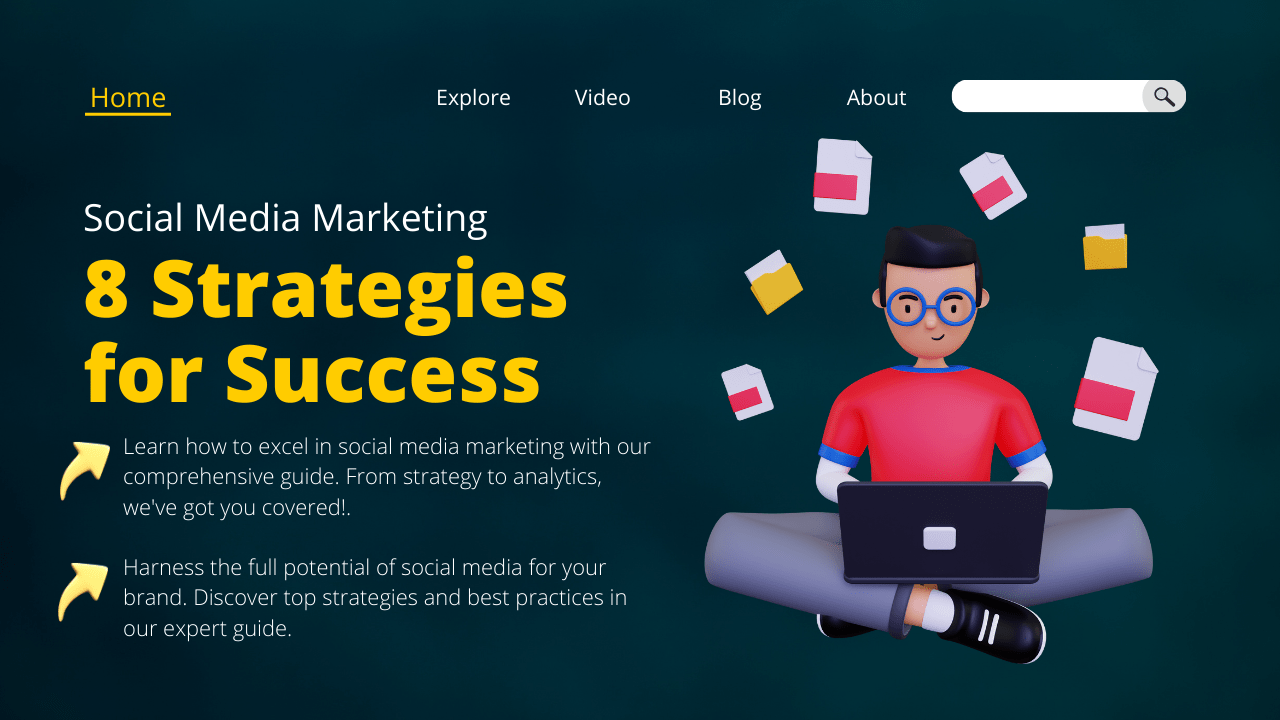Influencer Marketing: 7 Brand Awareness Boosts
Influencer marketing has become a game-changer in the world of digital marketing. It’s the art of collaborating with individuals who have a significant following and influence on social media platforms to promote your products or services. In this guide, we’ll delve into the power of influencer marketing and how it can skyrocket your brand awareness.
Introduction to Influencer Marketing
Influencer marketing has emerged as a potent and transformative tool for brands looking to enhance their brand awareness and connect with their target audience. This section will provide a more detailed understanding of what influencer marketing entails and why it is a game-changer for modern marketing strategies.
What is Influencer Marketing?
Influencer marketing is a strategy that involves partnering with individuals who possess a significant and dedicated following on social media platforms. These individuals, known as influencers, have established credibility and trust among their audience due to their expertise, authenticity, and engaging content. Brands collaborate with influencers to promote their products, services, or messages within the influencer’s content, thereby gaining access to a highly engaged and often niche audience.
The Power of Influencer Marketing in Boosting Brand Awareness
- Credibility and Trust: Influencers have built a strong rapport with their followers, and their recommendations are often viewed as trustworthy. When an influencer vouches for a brand or product, it carries significant weight with their audience, establishing trust that traditional advertising struggles to achieve.
- Targeted Reach: Influencers have a follower base that typically aligns with a specific demographic or interest group. This allows brands to reach their ideal customers directly, reducing wasted marketing efforts and expenses.
- Authenticity: The authenticity and relatability of influencer content are critical. Audiences appreciate the genuine and personal touch that influencers bring to their recommendations, creating a more authentic connection between the brand and its potential consumers.
- Increased Engagement: Influencers foster active and engaged communities. Their content often sparks conversations and interactions, leading to higher engagement rates compared to traditional advertising methods.
- Content Diversity: Influencers are skilled in creating a variety of content formats, such as videos, images, stories, and blog posts. This diversity ensures that the brand’s message is delivered in a way that resonates with different types of audiences.
- Viral Potential: Exceptional influencer-generated content has the potential to go viral, exponentially increasing its reach and impact.
In summary, influencer marketing is not just a buzzword; it’s a dynamic strategy that can significantly elevate your brand’s awareness, establish trust with your audience, and drive authentic engagement. By harnessing the power of influencers, brands can unlock a world of opportunities to connect with their target customers and navigate the digital marketing landscape effectively.

Identifying the Right Influencers
The success of your influencer marketing campaign hinges on your ability to identify the right influencers to collaborate with. This section provides an in-depth exploration of the key considerations and strategies for finding the perfect influencers for your brand.
Defining Your Target Audience
Before you can start your search for the ideal influencers, you must have a clear understanding of your target audience. Identifying the characteristics, demographics, interests, and behaviors of your ideal customers is a critical first step. This data serves as a compass, guiding you towards influencers whose followers align with your target demographic.
- Demographics: Consider age, gender, location, income, and other demographic factors that define your audience.
- Interests and Passions: Analyze your audience’s interests, hobbies, and passions to find influencers who resonate with these areas.
- Online Behavior: Understanding how your audience consumes content, which platforms they prefer, and their online habits is essential.
Analyzing Influencer Relevance and Authenticity
Once you have a clear picture of your target audience, you can begin assessing influencers for their relevance and authenticity:
- Content Alignment: Ensure that the influencer’s content, values, and interests align with your brand. Collaborating with influencers whose content seamlessly integrates your product or message feels more natural to their audience.
- Engagement Levels: Evaluate the influencer’s engagement levels, such as likes, comments, shares, and the depth of interaction with their followers. High engagement is an indicator of an active and loyal audience.
- Follower Authenticity: Scrutinize the authenticity of an influencer’s follower base. Avoid influencers with a high number of fake or inactive followers, as this can skew the impact of your campaign.
- Previous Collaborations: Investigate their past collaborations and partnerships. Ensure that they have experience working with brands in a similar industry or with a similar target audience.
- Audience Trust: Seek influencers who have earned trust within their community. Trustworthy influencers are more likely to influence purchasing decisions.
Using Influencer Marketing Tools
Leveraging technology and influencer marketing tools can significantly simplify the process of identifying the right influencers. These platforms offer a range of features, such as:
- Audience Insights: They provide data about an influencer’s audience, including demographics, interests, and location, making it easier to match them with your target audience.
- Engagement Analytics: These tools can provide in-depth insights into an influencer’s engagement metrics, helping you understand how well they connect with their followers.
- Influencer Discovery: Many tools offer search functions that allow you to find influencers based on specific criteria, making it easier to narrow down your options.
- Fraud Detection: These tools often include features to detect fake followers or suspicious activity, ensuring the authenticity of an influencer’s audience.
By combining your knowledge of your target audience with these influencer marketing tools, you can make a well-informed decision about who to collaborate with. Remember, the right influencer not only possesses a significant following but also has the ability to authentically connect with your audience and convey your brand’s message effectively.

Building a Strong Influencer Partnership
Creating a robust and mutually beneficial partnership with influencers is a critical aspect of influencer marketing. In this section, we’ll delve deeper into the key elements of establishing and nurturing a strong relationship with influencers.
Crafting Compelling Collaboration Proposals
A well-crafted collaboration proposal is the first step in building a strong influencer partnership. Your proposal should be personalized, transparent, and value-driven. Consider the following:
- Personalization: Tailor your proposal to the specific influencer. Reference their previous work and explain why you believe they are an excellent fit for your brand.
- Clear Objectives: Clearly outline your goals and expectations for the collaboration. Whether it’s brand awareness, product promotion, or a specific campaign, the influencer should understand their role.
- Value Proposition: Highlight the benefits of the partnership for the influencer. This could include exposure to a new audience, compensation, exclusive access, or any other value they’ll gain.
- Transparency: Be open about compensation, content requirements, and any legal or ethical considerations. Transparency builds trust and ensures both parties are on the same page.
Negotiating Terms and Compensation
Effective negotiation is vital in establishing a successful influencer partnership. During this process:
- Define Compensation: Discuss compensation terms, whether it’s a flat fee, a commission, free products, or a combination. The influencer’s rates should align with their reach and impact.
- Content and Posting Schedule: Clearly define the content requirements, including the number of posts, types of content (e.g., photos, videos, stories), and posting schedule. Ensure it aligns with your campaign goals.
- Timeline and Deadlines: Agree on project timelines and deadlines. Influencers often have busy schedules, so it’s essential to coordinate effectively.
- Rights and Usage: Address content ownership, copyright, and usage rights. Be specific about who has the rights to the content and for how long.
- Ethical Considerations: Discuss disclosure and any other ethical considerations, ensuring the influencer complies with relevant regulations.
Legal and Ethical Considerations
Influencer marketing is subject to various legal and ethical guidelines. Ensure your influencer partnerships adhere to these principles:
- FTC Guidelines: In the United States, the Federal Trade Commission (FTC) requires influencers to disclose their relationship with brands. Ensure that influencers clearly mark sponsored content as required by law.
- Contracts: Draft a contract that outlines all the terms, conditions, and responsibilities of both parties. This legally binding document provides clarity and protection for all involved.
- Intellectual Property Rights: Specify content ownership and rights in the contract to avoid potential disputes in the future.
- Data Protection: If you’re sharing customer data with influencers, make sure it complies with data protection regulations, such as GDPR (General Data Protection Regulation) in Europe.
- Transparency: Maintain transparency throughout the partnership. Influencers should be open about their association with your brand, and you should be transparent about your expectations and compensation.
- Dispute Resolution: Include provisions for dispute resolution in the contract, outlining steps to be taken in case of conflicts.
Building a strong influencer partnership is a collaborative effort that requires clear communication, transparency, and mutual understanding. When both parties are aligned in terms of goals, expectations, and ethical considerations, the result is a fruitful and lasting relationship that benefits your brand and the influencer’s audience alike.

Creating Engaging Content
The heart of any influencer marketing campaign lies in the content created by influencers. In this section, we’ll explore the nuances of crafting compelling and engaging content that resonates with the audience while maintaining the authenticity of the influencer and your brand message.
Aligning Content with Your Brand’s Message
For influencer marketing to be successful, it’s imperative that the content aligns seamlessly with your brand’s message and values. Here’s how you can ensure this alignment:
- Brand Guidelines: Provide influencers with a detailed set of brand guidelines that encompass your brand’s tone, style, and messaging. This ensures consistency and a coherent brand image.
- Pre-Campaign Discussion: Have a thorough discussion with the influencer about your brand’s mission, goals, and the specific message you want to convey through the campaign.
- Storytelling: Encourage influencers to incorporate storytelling into their content. Narratives that resonate emotionally with the audience tend to be more engaging.
- Content Review: Review the content before it goes live to make sure it adheres to your brand’s message and values. Offer feedback and suggestions for improvements if necessary.
Leveraging Different Content Formats
The versatility of influencer marketing lies in its ability to tap into various content formats. Depending on your brand and campaign objectives, you can explore different content types:
- Video: Video content is increasingly popular and allows for in-depth storytelling. Consider product demonstrations, reviews, or day-in-the-life videos.
- Images: High-quality images can be attention-grabbing and are perfect for visual products or lifestyle shots.
- Stories: Instagram and Facebook Stories are short-lived and offer a sense of immediacy. They’re great for teasers, behind-the-scenes content, or quick updates.
- Blog Posts: Influencers can write in-depth blog posts to provide a comprehensive review or discussion related to your product or service.
- Livestreams: Live broadcasts allow real-time interaction with the audience, making it ideal for Q&A sessions, product launches, or unboxings.
- Interactive Content: Quizzes, polls, and challenges can drive engagement and interaction within the influencer’s audience.
Ensuring Authenticity in Influencer-Generated Content
One of the most critical elements in influencer marketing is maintaining authenticity. Authenticity is what sets influencer content apart from traditional advertising:
- Trust the Influencer’s Style: Allow influencers creative freedom and trust their style. Their followers follow them because of their authenticity, so let it shine through.
- Transparent Collaboration: Encourage influencers to be transparent about the collaboration with your brand. Authenticity often stems from honest and open communication.
- Real-life Usage: Whenever possible, showcase your product or service being used in real-life situations. This provides a genuine context for the product.
- Engage with the Audience: Encourage the influencer to engage with their audience by responding to comments and questions. This interaction adds a layer of authenticity.
- User-Generated Content: Encourage influencers to share user-generated content from their audience. This demonstrates real customer experiences and engagement.
Creating engaging content in influencer marketing involves a delicate balance between aligning with your brand’s message, experimenting with various content formats, and preserving the influencer’s authenticity. The magic happens when this synergy results in content that not only promotes your brand but also resonates with the audience on a personal and emotional level.

Launching Effective Campaigns
The success of an influencer marketing campaign heavily relies on how well you plan, execute, and manage the campaign itself. In this section, we’ll delve deeper into the strategies and considerations for launching effective influencer marketing campaigns.
Setting Clear Objectives and KPIs
Your campaign’s success begins with setting clear objectives and key performance indicators (KPIs). Without well-defined goals, you won’t be able to measure the effectiveness of your campaign. Consider the following:
- Specificity: Ensure that your objectives are specific, measurable, achievable, relevant, and time-bound (SMART). For example, “Increase brand awareness by 20% in three months.”
- Alignment with Business Goals: Align your campaign objectives with your broader business goals, whether they’re related to brand awareness, lead generation, or sales.
- KPIs: Identify the key metrics that will help you gauge the success of your campaign, such as reach, engagement rates, click-through rates, conversions, or return on investment (ROI).
- Benchmarking: Compare your campaign’s performance with industry benchmarks and past campaigns to gauge its success.
Campaign Planning and Execution
Once you’ve set your objectives, it’s time to plan and execute your influencer marketing campaign effectively:
- Content Strategy: Work closely with influencers to create a detailed content strategy. Define the type of content, posting schedule, and key messages to be conveyed.
- Content Approval: Review and approve influencer-generated content before it goes live to ensure it aligns with your brand guidelines and campaign objectives.
- Scheduling: Coordinate with influencers to schedule content publication for optimal reach and engagement. Consider peak posting times and relevant dates.
- Promotion: Plan the promotion of influencer content on your brand’s social media accounts and other marketing channels to maximize its reach.
- Tracking Links: Use tracking links or UTM parameters to monitor the performance of links and measure the traffic generated by influencers.
- Hashtags and Campaign-Specific Elements: Create campaign-specific hashtags, landing pages, or microsites to track the campaign’s impact and engage with the audience.
- Content Consistency: Ensure that the campaign’s message remains consistent across all influencers, platforms, and content types.
Monitoring and Adjusting Your Campaign
Real-time monitoring and the ability to adjust the campaign as needed is essential for its success:
- Analytics Tools: Utilize analytics tools to track the performance of your campaign in real-time. Monitor metrics like reach, engagement, click-through rates, and conversions.
- Engagement: Pay attention to the engagement on influencer posts, both positive and negative. Respond to comments and engage with the audience to create a more significant impact.
- Feedback Loop: Maintain open communication with influencers. Provide feedback and make adjustments as needed during the campaign to ensure it meets its objectives.
- Contingency Plans: Be prepared with contingency plans for unexpected circumstances or negative responses. Have strategies in place for managing any crisis or backlash effectively.
- A/B Testing: Experiment with different approaches and content types to identify what resonates best with the audience and make adjustments accordingly.
- Budget Management: Keep a close eye on your campaign budget to ensure that it’s utilized efficiently. Allocate additional funds if a specific influencer or content type is performing exceptionally well.
Launching effective influencer marketing campaigns requires meticulous planning, clear objectives, real-time monitoring, and the flexibility to adapt as needed. Successful campaigns not only achieve their intended goals but also establish a positive brand image, foster audience engagement, and contribute to long-term brand growth.

Measuring and Analyzing Results
Measuring and analyzing the results of your influencer marketing campaign is crucial for determining its success and improving future strategies. In this section, we’ll explore the key steps and considerations for effective measurement and analysis.
Key Metrics to Track
To evaluate the impact of your influencer marketing campaign, it’s essential to track relevant key performance indicators (KPIs). Some of the most important metrics to monitor include:
- Engagement Rates: Measure likes, comments, shares, and other interactions on influencer posts to gauge the level of audience engagement.
- Reach and Impressions: Calculate the number of people who saw the influencer’s content and how many times it was viewed.
- Click-Through Rates (CTR): Determine how many people clicked on links or calls to action within the influencer’s content, leading to your website or landing page.
- Conversions: Track the number of conversions resulting from the campaign, whether they are sales, sign-ups, or any other desired actions.
- Return on Investment (ROI): Calculate the overall return on investment by comparing the campaign’s cost to the revenue or value generated.
- Audience Growth: Monitor changes in your social media following or email subscriber list to assess the campaign’s impact on your audience.
- Sentiment Analysis: Analyze audience sentiment through comments, reviews, and feedback to understand the overall perception of your brand.
- Content Performance: Evaluate which content types, topics, or influencers performed the best in terms of engagement and conversions.
Using Analytics Tools
Leveraging analytics tools is essential for gathering and interpreting campaign data. Several tools can help you track and measure influencer marketing results:
- Google Analytics: Utilize Google Analytics to track website traffic, conversions, and user behavior resulting from influencer-driven traffic.
- Social Media Insights: Most social media platforms offer built-in analytics that provide data on post performance, audience demographics, and engagement.
- Influencer Marketing Platforms: Many influencer marketing platforms come with their own analytics tools that provide detailed insights into campaign performance.
- URL Shorteners: Use URL shorteners like Bitly or UTM parameters to track the click-through rates and conversions from influencer links.
- Customer Relationship Management (CRM) Tools: CRM systems can help you monitor customer interactions, leads, and sales generated by the campaign.
- Surveys and Feedback: Collect feedback from the audience through surveys or post-campaign interviews to gain qualitative insights.
Evaluating ROI
Determining the return on investment (ROI) is crucial to assess the financial success of your influencer marketing campaign. To calculate ROI:
- Subtract the cost of the campaign (influencer fees, content production, and other expenses) from the revenue generated from the campaign.
- Divide the result by the cost of the campaign.
- Multiply by 100 to express the ROI as a percentage.
A positive ROI indicates that your campaign has been profitable, while a negative ROI may necessitate a reevaluation of your approach.
Iterative Analysis and Future Planning
Influencer marketing is an evolving field, and campaign results offer valuable insights for future strategies:
- Regularly analyze your influencer marketing data to identify trends, successful approaches, and areas for improvement.
- Identify what worked well and what didn’t, adjusting your strategy accordingly for future campaigns.
- Keep track of changes in your industry and adapt your influencer marketing strategies to stay relevant.
- Continuously refine your influencer selection process, content strategy, and measurement techniques based on the analysis of past campaigns.
- Collaborate with influencers to gather their feedback and insights on campaign performance, and use their expertise to enhance future campaigns.
Measuring and analyzing influencer marketing results involves a combination of quantitative data, feedback, and insights. A thorough analysis not only provides a clear picture of your campaign’s effectiveness but also serves as a foundation for refining your strategies and achieving long-term success in influencer marketing.

Case Studies: Successful Influencer Marketing Campaigns
Learning from real-world examples of successful influencer marketing campaigns can provide invaluable insights into the strategies and approaches that yield positive results. In this section, we’ll explore a few case studies that highlight the effectiveness of influencer marketing in different industries and contexts.
1. Daniel Wellington – Micro-Influencer Collaboration
Daniel Wellington, a Swedish watch company, is renowned for its highly successful influencer marketing campaigns. They strategically leveraged micro-influencers (influencers with a smaller but more engaged following) in their campaign.
Campaign Objective: Boost brand awareness and drive sales for their watches.
Approach:
- Identified a range of micro-influencers in the fashion and lifestyle niches, each with a few thousand followers.
- Provided each influencer with a unique discount code to track conversions.
- Encouraged influencers to post high-quality images wearing the watches.
- Amplified the campaign’s reach by re-sharing influencer content on the brand’s own social media.
Results:
- The campaign generated significant brand awareness and increased sales.
- Micro-influencers’ authentic content resonated well with their followers.
- The campaign’s success led to a surge in demand for Daniel Wellington’s watches.
2. Glossier – User-Generated Content
Glossier, a skincare and makeup brand, has masterfully incorporated user-generated content into their influencer marketing strategy.
Campaign Objective: Promote their products while emphasizing authenticity and inclusivity.
Approach:
- Encouraged customers and fans to create content featuring their products and use a campaign-specific hashtag.
- Showcased user-generated content on their website and social media channels.
- Collaborated with beauty influencers to promote the campaign and provide tutorials and reviews.
Results:
- The campaign demonstrated authenticity and inclusivity by featuring content from a diverse range of customers.
- User-generated content increased engagement and trust among the audience.
- The campaign significantly expanded Glossier’s reach and boosted sales.
3. Coca-Cola – Emotional Storytelling
Coca-Cola’s “Share a Coke” campaign is a prime example of using influencer marketing to tell emotional and heartwarming stories.
Campaign Objective: Reinforce the brand’s image as a source of happiness and bring people together.
Approach:
- Partnered with influencers from various backgrounds and regions.
- Encouraged influencers to share personal stories and experiences associated with Coca-Cola, emphasizing the brand’s role in their lives.
- Created a campaign-specific hashtag to encourage audience participation.
Results:
- The campaign’s emotional storytelling resonated with the audience, eliciting a sense of nostalgia and happiness.
- The hashtag #ShareACoke became a viral trend, with consumers sharing their own stories.
- The campaign strengthened Coca-Cola’s image as a brand that brings people together.
4. Adobe – Educational Influencer Collaborations
Adobe, the software giant, effectively utilized influencer marketing to provide educational content and engage its target audience.
Campaign Objective: Position Adobe as an industry leader and promote its creative software.
Approach:
- Collaborated with influential artists, designers, and creatives who used Adobe products.
- Influencers created tutorials, workshops, and in-depth content showcasing Adobe software’s capabilities.
- Shared this educational content on Adobe’s platforms, engaging both existing and potential customers.
Results:
- The campaign established Adobe as a go-to source for creative knowledge.
- The educational content was widely shared and engaged Adobe’s audience in meaningful ways.
- The company strengthened its relationship with the creative community, which, in turn, led to increased brand loyalty and product usage.
These case studies demonstrate the versatility and impact of influencer marketing in various industries. They highlight the importance of aligning campaign objectives with the right influencers, creating authentic and engaging content, and effectively measuring campaign success. By drawing inspiration from these successful examples, brands can tailor their influencer marketing strategies for similar achievements in their respective niches.
Conclusion
Influencer marketing has evolved into a dynamic and effective strategy for brands seeking to boost brand awareness, engage with their target audience, and drive sales. The key to a successful influencer marketing campaign lies in meticulous planning, thoughtful execution, and thorough analysis. By identifying the right influencers, crafting engaging content, and measuring results, brands can tap into the power of influencer marketing to thrive in the competitive digital landscape.
Key Takeaways
- Choose the Right Influencers: Select influencers whose followers align with your target audience, and ensure they are authentic and aligned with your brand values.
- Craft Engaging Content: Content should be in sync with your brand’s message, leverage various formats, and maintain the authenticity of the influencer.
- Set Clear Objectives and KPIs: Clearly define campaign goals, KPIs, and align them with your business objectives.
- Use Analytics Tools: Leverage analytics tools to monitor and measure campaign performance in real-time.
- Evaluate ROI: Calculate the return on investment to assess the financial success of the campaign.
- Iterate and Improve: Continuously analyze results to refine your influencer marketing strategies for future campaigns.
FAQs
1. What is the difference between micro-influencers and macro-influencers?
Micro-influencers have a smaller but highly engaged following, while macro-influencers have a larger, more general audience. Micro-influencers often offer a more authentic and niche connection with their followers.
2. How do I find the right influencers for my brand?
To find the right influencers, define your target audience, use influencer marketing tools, and assess influencer authenticity and relevance.
3. What are the key metrics to track in influencer marketing?
Key metrics include engagement rates, reach and impressions, click-through rates, conversions, ROI, audience growth, and sentiment analysis.
4. How can I maintain authenticity in influencer marketing campaigns?
Allow influencers creative freedom, maintain transparency, and engage in open communication. Encourage influencers to be authentic and genuine in their content.
5. What are the benefits of using user-generated content in influencer marketing?
User-generated content enhances authenticity and inclusivity, increases engagement, and fosters trust among the audience. It can significantly expand your brand’s reach and boost sales.
Photo by Pexels
















